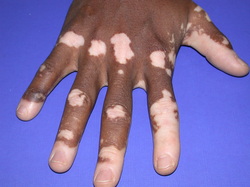|
|
Pathology definition - Vitiligo

Vitiligo
Vitiligo may present with patches of flat, loss of pigment lesion with irregular border ( white patches). Vitiligo typically present on the skin around the eyes, of the hand, around the mouth and axillae.
Vitiligo is due to the loss of melanocytes that is acquired as a result of destruction of the melanocytes by toxic substance or due to autoimmune disease which affect the synthesis of melanocytes.
Vitiligo is different from albinism as in vitiligo there will be an absence of the melanocytes in the skin. Vitiligo may be treated by preventing any sun exposure which may lead to actinic keratoses or skin cancer as well as considering topical corticosteroid.
Vitiligo is associated with autoimmune diseases such as pernicious anemia, Hashimoto thyroiditis, Graves disease and Addison disease.
References
1.S, Handa, and Kaur I. “Vitiligo: Clinical Findings in 1436 Patients.” The Journal of Dermatology 26, no. 10 (October 1999): 653–657.
2.Alkhateeb, Asem, Pamela R. Fain, Anthony Thody, Dorothy C. Bennett, and Richard A. Spritz. “Epidemiology of Vitiligo and Associated Autoimmune Diseases in Caucasian Probands and Their Families.” Pigment Cell Research 16, no. 3 (2003): 208–214. doi:10.1034/j.1600-0749.2003.00032.x.
Vitiligo may present with patches of flat, loss of pigment lesion with irregular border ( white patches). Vitiligo typically present on the skin around the eyes, of the hand, around the mouth and axillae.
Vitiligo is due to the loss of melanocytes that is acquired as a result of destruction of the melanocytes by toxic substance or due to autoimmune disease which affect the synthesis of melanocytes.
Vitiligo is different from albinism as in vitiligo there will be an absence of the melanocytes in the skin. Vitiligo may be treated by preventing any sun exposure which may lead to actinic keratoses or skin cancer as well as considering topical corticosteroid.
Vitiligo is associated with autoimmune diseases such as pernicious anemia, Hashimoto thyroiditis, Graves disease and Addison disease.
References
1.S, Handa, and Kaur I. “Vitiligo: Clinical Findings in 1436 Patients.” The Journal of Dermatology 26, no. 10 (October 1999): 653–657.
2.Alkhateeb, Asem, Pamela R. Fain, Anthony Thody, Dorothy C. Bennett, and Richard A. Spritz. “Epidemiology of Vitiligo and Associated Autoimmune Diseases in Caucasian Probands and Their Families.” Pigment Cell Research 16, no. 3 (2003): 208–214. doi:10.1034/j.1600-0749.2003.00032.x.
